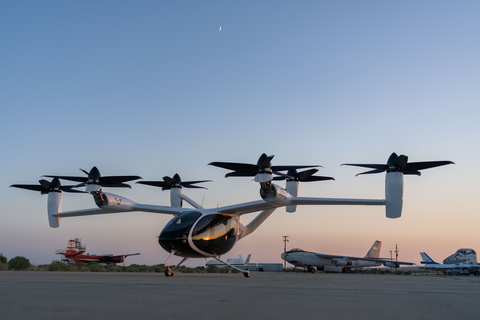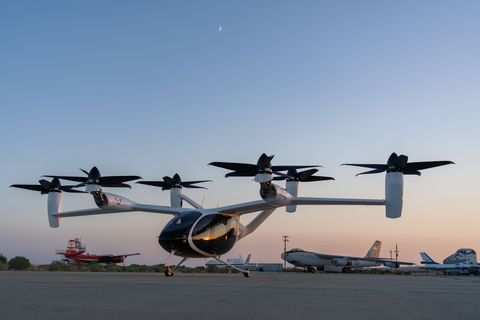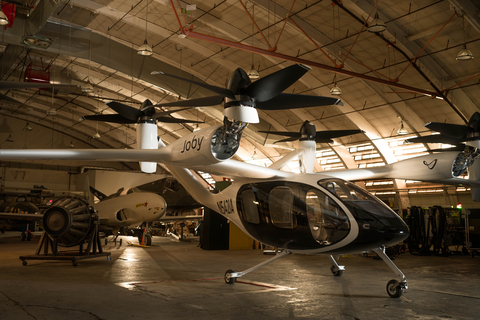SANTA CRUZ, Calif. & EDWARDS AIR FORCE BASE, Calif.--(BUSINESS WIRE)--Joby Aviation, Inc. (NYSE:JOBY), a company developing electric vertical take-off and landing (eVTOL) aircraft for commercial passenger service, today announced it has delivered its first aircraft to Edwards Air Force Base approximately six months ahead of the expected 2024 delivery date. On-base operations with Joby aircraft will be used to demonstrate a range of logistics missions, including cargo and passenger transportation, and will be operated by both Joby and U.S. Air Force personnel. In partnership with the U.S. Air Force, NASA will also use the aircraft for research focused on how these aircraft could fit into the national airspace, benefiting the entire air taxi industry.
Joby’s aircraft, which has already begun flying at Edwards AFB, is the first electric air taxi to be stationed on a U.S. military base and is believed to be the first delivery of an electric air taxi in the U.S., as part of Joby’s $131 million AFWERX Agility Prime contract with the U.S. Air Force. Joby’s current and previously completed work with the Department of Defense represents a total potential contract value of $163 million, the largest in the industry.
The Agility Prime contract includes the provisioning of up to nine aircraft to the U.S. Air Force and other federal agencies, reinforcing the U.S. government’s continued leadership in developing and adopting eVTOL technology, and ushering in a new era of electric aviation. A second aircraft is planned to be delivered to Edwards in early 2024.
The aircraft, which was the first built on Joby’s Pilot Production Line in Marina, CA, will be stationed at Edwards Air Force Base for at least the next year, with charging and ground support equipment provided on-base by Joby in a facility purpose-built by the Air Force for joint flight test operations. The U.S. Air Force and Joby will conduct joint flight testing and operations to demonstrate the aircraft’s capabilities in realistic mission settings. On-base operations will also include the training of Air Force pilots and aircraft maintenance crews, which will provide the DOD with valuable insight into the performance of eVTOL aircraft and will give Joby on-the-ground operational and training experience as the company prepares for the launch of commercial passenger service in 2025.
“We’re proud to join the ranks of revolutionary aircraft that first demonstrated their capabilities at Edwards Air Force Base, including the first American jet fighter, the first supersonic aircraft, and many others that have pushed the boundaries of aviation technology,” said JoeBen Bevirt, Founder and CEO of Joby.
“The longstanding support of the DOD and NASA has been critical to the rapid development of electric aviation and eVTOL aircraft, and demonstrates how successful public-private partnerships can bring new technology to life at speed. Their work will have profound implications for continued American leadership in both commercial and defense aerospace technology,” he added.
Joby’s partnership with the DOD dates back to its 2016 engagement with the Defense Innovation Unit (DIU), which granted the company early funding as well as access to test ranges and expertise that have aided its aircraft development program.
“Agility Prime’s stated objective in 2020 was to work towards an operational capability for transformative vertical lift in the DoD by 2023. The arrival of Joby’s aircraft at Edwards AFB is an important step towards achieving this objective,” said Col Elliott Leigh, AFWERX director and Chief Commercialization Officer for the Department of the Air Force.
“The delivery of this first eVTOL aircraft is the start of a new chapter in Edwards’ rich aerospace history,” notes Maj Phillip Woodhull, director, Emerging Technologies Integrated Test Force. “This partners private industry with the 412th Test Wing’s world-renowned test management execution. We are excited to agilely test, experiment with, and evaluate this new technology for potential future national defense applications.”
In partnership with the U.S. Air Force’s AFWERX program, NASA will also be supporting this testing at Edwards Air Force Base with NASA’s pilots, researchers, and equipment as part of their commitment to advancing the Advanced Air Mobility industry as a whole, for the benefit of all. NASA’s Armstrong Flight Research Center is located on Edwards Air Force Base, and has a long history of supporting important technological milestones in aviation and space – supersonic and hypersonic flight, digital fly-by-wire control systems, and the space shuttles.
“NASA’s participation in the Joby and AFWERX project will provide our researchers with hands-on experience with a representative eVTOL vehicle, concentrated on how these types of aircraft could fit into the national airspace for everyday use, that will inform NASA’s effort in supporting the entire eVTOL industry,” said NASA research pilot Wayne Ringelberg. “The research will include a focus on handling qualities evaluation tools, autonomy, and airspace integration, which is all needed research to push the industry forward.”
Over the past year, the U.S. Air Force and Marines have made multiple visits to Joby’s manufacturing and flight test facilities in Marina, CA. Four U.S. Air Force pilots completed full remotely-piloted transition flights of the Joby aircraft in April, and two groups of Marines visited in May to conduct mission analysis regarding potential logistics and medical applications of the aircraft.
With a range of up to 100 miles plus energy reserves and a top speed of 200 mph, the Joby aircraft is capable of transporting a pilot and four passengers quickly and quietly with zero operating emissions.
The delivery will be celebrated at an event held this morning at 10:00am PT at Edwards Air Force Base. The event can be watched live via this link: https://www.youtube.com/watch?v=6qVLQsz_YJc.
Media assets, including photos and videos of the Joby aircraft in flight, are available here.
About Joby
Joby Aviation, Inc. (NYSE:JOBY) is a California-based transportation company developing an all-electric, vertical take-off and landing air taxi which it intends to operate as part of a fast, quiet, and convenient service in cities around the world. To learn more, visit www.jobyaviation.com.
About AFRL
The Air Force Research Laboratory is the primary scientific research and development center for the Department of the Air Force. AFRL plays an integral role in leading the discovery, development, and integration of affordable warfighting technologies for our air, space and cyberspace force. With a workforce of more than 11,500 across nine technology areas and 40 other operations across the globe, AFRL provides a diverse portfolio of science and technology ranging from fundamental to advanced research and technology development. For more information, visit www.afresearchlab.com.
About AFWERX
The innovation arm of the DAF and a directorate within the Air Force Research Laboratory brings cutting edge American ingenuity from small businesses and start-ups to address the most pressing challenges of the DAF. Employs approximately 325 military, civilian and contractor personnel at six hubs and sites executing an annual $1.4B budget. Since 2019, has executed 4,671 contracts worth more than $2B to strengthen the U.S. defense industrial base and drive faster technology transition to operational capability. For more information, visit: www.afwerx.com.
Forward Looking Statement
This press release contains “forward-looking statements” within the meaning of the “safe harbor” provisions of the Private Securities Litigation Reform Act of 1995, including but not limited to, statements regarding the development and performance of our aircraft, the growth of our manufacturing capabilities, our regulatory outlook, progress and timing, including our expectation to start commercial passenger service in 2025, the expected timing of type certification; our plans related to on-base operations with the Department of Defense including the timing and number of aircraft to be delivered, expected use cases, and the total potential value of our contracts; our business plan, objectives, goals and market opportunity; plans for, and potential benefits of, our strategic partnerships; and our current expectations relating to our business, financial condition, results of operations, prospects, capital needs and growth of our operations, including the expected benefits of our vertically-integrated business model. You can identify forward-looking statements by the fact that they do not relate strictly to historical or current facts. These statements may include words such as “anticipate”, “estimate”, “expect”, “project”, “plan”, “intend”, “believe”, “may”, “will”, “should”, “can have”, “likely” and other words and terms of similar meaning in connection with any discussion of the timing or nature of future operating or financial performance or other events. All forward looking statements are subject to risks and uncertainties that may cause actual results to differ materially, including: our ability to launch our aerial ridesharing service and the growth of the urban air mobility market generally; our ability to produce aircraft that meet our performance expectations in the volumes and on the timelines that we project, and our ability to launch our service; the competitive environment in which we operate; our future capital needs; our ability to adequately protect and enforce our intellectual property rights; our ability to effectively respond to evolving regulations and standards relating to our aircraft; our reliance on third-party suppliers and service partners; uncertainties related to our estimates of the size of the market for our service and future revenue opportunities; and other important factors discussed in the section titled “Risk Factors” in our Annual Report on Form 10-K, filed with the Securities and Exchange Commission (the “SEC”) on March 1, 2023, and in future filings and other reports we file with or furnish to the SEC. Any such forward-looking statements represent management’s estimates and beliefs as of the date of this presentation. While we may elect to update such forward-looking statements at some point in the future, we disclaim any obligation to do so, even if subsequent events cause our views to change.






